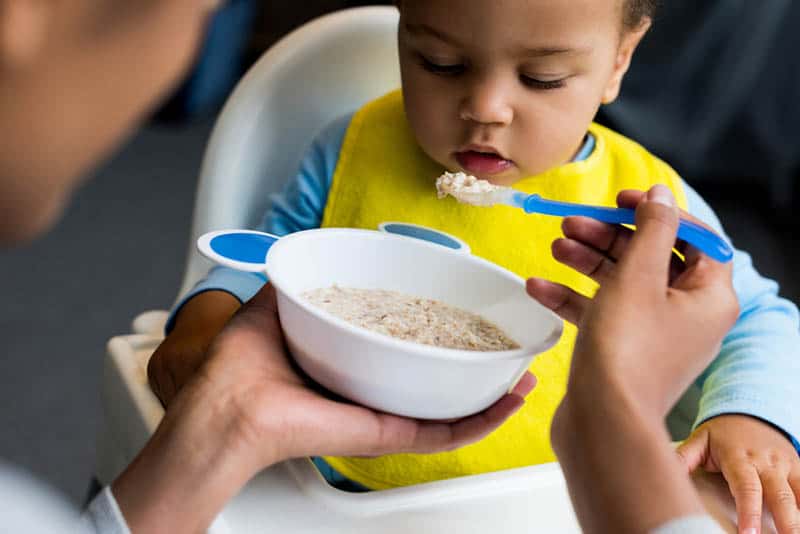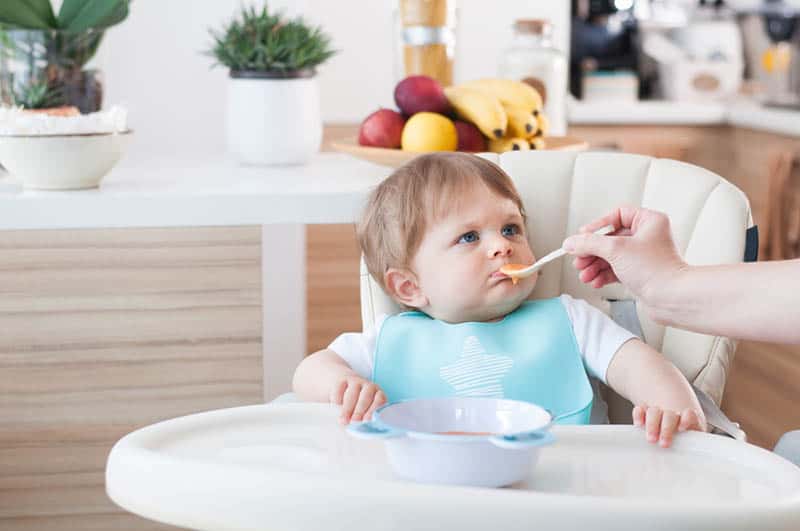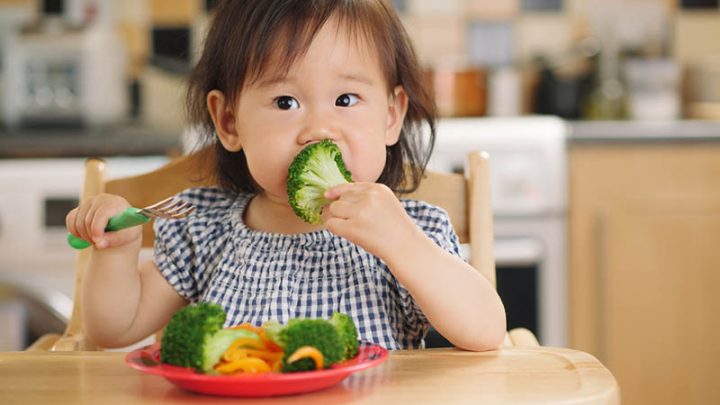Figuring out how to get toddlers to eat vegetables has been a question that has baffled every new mom for many years!.
It can be a nightmare to deal with picky eaters during mealtime, but it’s really about finding the right angle of approach.
Every child is different and is going to have different tastes.
This means that it’s important to remember that every kid requires different methods to get them to eat veggies.
Some might be extremely reluctant when new foods are introduced to their diet, especially if they catch a whiff of a vegetable, while others might just accept them without any fuss.
Shocking, isn’t it? When I was getting my first child accustomed to eating veggies, she didn’t protest at all. She just ate them all up with gusto because she “liked the colors”.
My second was a much tougher nut to crack,r and he was quite a picky eater to begin with. I needed to employ several different tricks in order to get him his daily dose of veggies.
Some were easy, some were hard and sometimes I simply needed to put my foot down, but they all worked out in the end.
Now, I will share my methods with you. Let’s take a look at them!.
9 Tips On How To Get Toddlers To Eat Vegetables
1. Exposure is key

The main thing you need to do is never give up when trying to teach your child that veggies are good for them and important for the body’s overall wellness.
That’s why it’s important to always include vegetables in every meal, as a side to the main course.
While your 2 year old might treat them as a decoration the majority of the time, sometimes they’ll get curious.
If he sees the entire family eating vegetables and you are very insistent on having things like green beans, broccoli and celery as a side, he might end up giving them a try.
Although they might not like it at first, they might begin to enjoy the taste this way and what used to be a horrible vegetable could end up being their favorite snack.
My son used to be this way with celery for instance. He hated the very sight of it.
But, after I began replacing french fries with celery sticks in some meals, he gave them a go with some sour cream dip on the side, and found it to be a delicious alternative.
2. Mixing veggies into dips

Speaking of dips, they’re another neat, but sneaky way of getting veggies into your little one’s diet.
If your child has an issue with how vegetables taste, a good helping of hummus, sour cream or barbecue sauce are going to be more than enough to help mask the taste of a vegetable they don’t enjoy.
You can use the aforementioned celery sticks, though I’ve heard that people have had better luck with carrot sticks or snap peas because the flavors blend better.
That said, I stand behind my choice because my son seems to enjoy that extra crunch!.
3. Juicing them

A juicer can be a real godsend when you’re trying to figure out how to get toddlers to eat vegetables.
It does have an unfortunate downside, in that you lose out on the fiber from the fruits and vegetables.
However, that’s something that can easily be replaced, unlike the healthy vitamins, minerals and nutrients found in the juice you are left with.
It requires a lot less effort on your child’s part. It’s funny when you realize how the need for a lot of chewing ends up making toddlers develop food aversions.
This isn’t just a problem with vegetables, but meat and everything else, too.
Not to mention that juicing eliminates the potential risk of choking hazards presented by solid foods that might have potentially been too big for your little one to chew up. t.
As far as the juicer itself goes, look for one that’s both easy to clean and that wastes as little juice as possible.
This way you will be using as much of the produce that comes fresh off the farmers’ market as possible.
Also, you won’t be giving yourself too much trouble with certain cumbersome juicers that are a nightmare to clean properly and disassemble.
As far as working out the types of vegetables that are good for juicing, there are two ways to go about finding out.
The first is trusting your gut and going through some trial and error. This will turn out well most of the time, as long as you stick to single flavors.
I recommend starting off with some classic fruit juices first, like apples and oranges, before slowly transitioning to some juicier vegetables.
Think of beets and carrots to begin with and, if you’re feeling adventurous, work your way up to cucumbers, celery and kale.
All of these are surprisingly tasty when you take the veggie texture out of them, and you are just left with the juice, particularly the slight tang of cucumber.
It’s best to see what fits your child the best and stick to it, I wouldn’t go into too many different flavors unless your child specifically asks for them.
The second option is to simply consult with a nutritionist or a registered dietitian on what fruits and vegetables are best suited for juicing.
This is ultimately the easiest option and is guaranteed to get you results quicker, though it might not be tailored to your child’s preferences.
With all that said, don’t forget to wash the vegetables thoroughly before juicing them. You don’t want to find any nasty surprises in your juice, after all.
4. Make some vegetable smoothies

Another sneaky and relatively easy way of getting your child some veggies in his tummy is to make him a healthy smoothie.
While the options might be a bit more limited here, it works in a similar way to juicing.
Plus, a cold serving of pureed fruits and vegetables might be something your child ends up enjoying more than just simple juice.
I know mine goes absolutely nuts for smoothies, no matter what’s inside them.
And despite the limitations mentioned above, most fruits are still on the table, as are certain seeds.
As far as vegetables go, kale, zucchini and spinach are all excellent for smoothies.
That said, I’d suggest talking with your nutritionist, or any registered dietitian, about what other veggies might make a good addition to your smoothies.
I’ve heard that carrots are great in smoothies, but have yet to try them myself.
However, this option is a bit less useful than juice if you have a lactose intolerant child, seeing as the base is dairy.
Make sure you keep that in mind before you attempt this method.
5. Vegetables as a first meal

While all these sneaky ways might be useful, it’s sometimes best to be upfront about what you want your child to add to his diet to expand his palate.
One way of doing this is to serve the first part of lunch as nothing but vegetables, with the actual main course coming shortly after.
You might get a few odd looks from your child, but if you’re persistent enough and you include the whole family in this, and not just him, you might see him come around to it.
I’ve had some success with this myself, though it did take a really long time, but you could end up having better results than me.
Besides, you might even end up having full veggie meals at some point in the future if he ends up liking it.
I do recommend trying some more visually appealing dishes first though, as presentation is very important when it comes to food. They say we eat with our eyes after all!
6. Serving the vegetables alongside a hated food

This would be the other upfront method, sort of.
By presenting your child with the option of two things they don’t like, he’s more likely going to go for the choice he hates the least.
Make sure that ends up being the vegetables.
While this is not the ideal method, seeing as how the rest of the food might end up going to waste, it might end up getting good results as far as encouraging your toddler to eat veggies is concerned.
At the very least, you can bargain with him and tell him that you’ll eat the rest if he eats his vegetables.
That way you won’t have to waste any food. Just make sure you have enough room left over for it yourself!
7. Exploring different recipes

The problem with getting toddlers to eat vegetables might not always be the vegetable itself, but rather the way it’s presented.
Kids don’t like looking at discolored veggies that have had all the good nutrients boiled away, leaving them with a chewy and unappetizing meal.
I suggest looking up different ways in which the vegetables you’re presenting to them can be prepared, and experimenting until you find the best way to appeal to your child.
Veggies are great to work with because they’re so flexible, so use that flexibility to your advantage, and bring the fun of eating healthily to your kids.
RELATED: Baby Food Recipes: Yummy And Easy Homemade Baby Food
8. Presenting them in a more appealing way

Flavor will only get you so far, the other half of the battle is in the presentation. If the vegetables don’t look appealing to the eye, the chances of your child even trying them are lessened.
Different methods of preparation will get you the best results here. For instance, roasting a vegetable in the oven to make it crunchy, instead of soggy from boiling or steaming, might end up being more to your child’s liking.
It can also be as simple as cutting a vegetable up into smaller pieces so they can start slowly and try it first, without having to look at the entire thing.
Celery is a good example of this. While it can look unappealing in large chunks, simply slicing it up into smaller pieces might get your kids to eat it. Once they’re hooked, you can slowly stop cutting it up.
9. Hiding the vegetables in other foods

Returning to the sneaky methods, this one has proven to have the biggest success rate with my son.
Not just because it’s helpful for sneaking the veg in, but also for telling him what he ate after he admitted it was good.
While the child may end up with a big surprise, you’ll find that he might change his opinion of that specific vegetable after the revelation.
So much so, that he may protest less and less about its inclusion in other meals.
The options here are genuinely endless, as long as you can find different ways to subtly add vegetables to the mix.
For example, you can mix pureed cauliflower with some mashed potatoes and your child will never know the difference. The same also works for creamy soups!
Alternatively, you can use some of that cauliflower to make pizza crust.
This works like a charm and will go unnoticed thanks to the abundance of other flavors on the pizza. Pasta is also a great hiding place for veggies.
Whether it’s done by adding a few more shredded carrots or spinach to the sauce, or by grating some onions and celery into the minced meat you make the meatballs with, you’re sure to get positive results.
I’m sure you can think of some other ideas, just don’t forget to tell your child about it after he enjoys a few servings!.
Or keep it as your little secret, it’s completely up to you.
Where The Problem With Healthy Food Lies
Healthy eating should be a priority for every person that they actively pursue because of their base survival instinct, but sometimes they simply don’t.
There are a few problems with this, that aren’t exclusive to just your little one, but to every single person.
1. The presentation

Even though colorful vegetables are often quite pleasing to the eye when first observed, some people just get sick of seeing green all the time.
However, it’s not really the look of raw vegetables that’s the problem, it’s the way they look when they’re prepared that causes the biggest issue when it comes to figuring out how to get toddlers to eat their veggies.
No offense to any mammas out there, but a brownish stew full of swirly bits of veg, or a poorly cooked plate of brussels sprouts isn’t going to win any awards.
All it does is put kids off eating their vegetables!.
I’ve had trouble getting my son to eat anything new at first, before I realized that this was the main part of the problem. My dishes simply looked unappealing.
So much so, that the very sight of them would make my son gag before he even put it in his mouth.
That’s why I looked into some international cuisine to broaden the variety of foods I prepare.
This way, I was able to learn the most appealing way to prepare each vegetable so I could retain that healthy color while looking appetizing to even the pickiest eater.
2. The taste/smell

The most common issue is, of course, the taste of the food. Raw vegetables aren’t going to be as appealing to someone with an undeveloped palate compared to another with more refined taste.
They’ve become accustomed to delicious things like candy, whole grains and meat, and they see veggies as something that smells or tastes bad.
The key to resolving this problem is, once again, the presentation.
Sure, you can let your child have his hamburger or chicken nuggets, but there are ways to sneak vegetables in there to help your child get used to them without even knowing what they are eating.
Just treat them as a complement to the meal at the start or, as mentioned in the first problem, find some veggie meals that look and smell appealing.
However, if you want to fit a few more veggies in to help achieve proper balance, without also having to put in too much effort, then I recommend experimenting with tacos, dips, meatballs or even pizza.
It’s very easy to hide vegetables in dips, as long as you shred them up and sprinkle them in. As for tacos and pizza, you can simply try various toppings and see which of them work best.
My personal favorites are using some thinly sliced onions or mushrooms as outright toppings or adding some pureed carrots to the tomato sauce.
It’s even simpler with tacos, given how much healthy stuff you can fit inside.
For some reason, my son is happy to eat veggies if they are inside a taco with some minced meat, that he wouldn’t dream of eating anywhere else.
3. The texture

This was my biggest hurdle to overcome when I was getting used to healthy eating myself.
I could handle the way the food looked, and even the taste, but it was the somewhat alien texture that I found myself having the most trouble with as a child.
It turns out that this was a major issue for my son too.
He tailored his eating habits based on the snacks he tried early, finding the crunch of a carrot or a zucchini to be a bit too much. This instantly triggers his gag reflex and makes him dry heave!.
Believe me, it’s a very unpleasant experience and put me off veggies back in the day too.
But, I still enjoyed them in other forms, which is what I introduced to my own son, using a juicer or simply turning the problem veg into a puree and mixing it into a smoothie.
It still retains its color and all the healthy nutrients, but does lose the fiber when in juice form.
But, this way it’s much, much easier to stomach than it otherwise would be, and it worked really well with him.
Now he doesn’t dislike as many vegetables as he used to, but he can still only have some if they’re in a smoothie.
It might not be ideal, but it’s a good compromise.
4. The battle of wills between parent and child

The final hurdle is one that’s ever present.
You’re trying to figure out how to get toddlers to eat vegetables, being persistent in your methods and they still outright refuse to eat them.
It becomes a standoff and it always ends up coming down to who gives in first.
Make sure that you don’t falter in your efforts, especially when dealing with your young children.
Think of it as a hidden power struggle.
If you give in now, your child will learn that you have a breaking point.
He might even become more stubborn the next time you want to try getting him to try something new, or to stop doing something that’s clearly bad for him.
As effective as it is to use sneaky ways to get your child to eat new vegetables, you shouldn’t ignore simply presenting them openly as a side dish.
I’ve learned that it helps to make it the first course of the meal, as odd as that may sound.
Using vegetables as a prerequisite before getting to the second course, which contains the stuff that they’d normally like to eat, is a great method.
But don’t restrict it just to them, this will simply alienate the child.
Make sure that the whole family is treated the same way and make it seem as if it’s a normal part of lunch.
That way, it won’t feel weird and your child won’t feel punished for having to eat his vegetables.
He’ll be more open to the idea of trying new things and finishing his plate to get to what he prefers, and you can slowly start mixing the two courses together into one again.
EXTRA: Using bribery as a tool
While some of the methods mentioned above may come across as borderline bribery, the course of action that I want to discuss now is one that I would personally not recommend.
Bribing your child with a later bedtime or more tv/game time might provide some good initial results, but it’ll only end up spoiling him in the long run.
It’ll teach him to be as stubborn as a mule until he gets his way, whenever you want to try new things. Believe me, that’s not the kind of child you want to raise.
It’s important to establish boundaries here, and develop healthy habits that are nurtured throughout his childhood, that will take hard work on your part as well as his.
So don’t take the easy way out, and rely on the 7 methods mentioned above.
In Conclusion
When trying to answer the question of How to get toddlers to eat vegetables, there are a variety of methods that can work.
But remember that not every method is universally effective and that every child has their individual preferences.
What worked for my son might not work for yours, which is why I encourage you to experiment with the methods I mentioned here.
If you’re still feeling confused, I suggest talking to a registered dietitian, a nutritionist or even a pediatrician to get some extra advice.
They can help you figure out a more personalized plan for getting your child to eat more veggies, and which ones will benefit them the most as well as the ones that they’re least likely to reject.
I do hope you end up having the same success as I did with my own kids, and that your little one becomes a happy little bunny munching on carrots like candy!
READ NEXT: Sweet Potato Tots with Hidden Veggies (Paleo, Gluten Free, Dairy Free, Egg Free)
Like this article? Please share or pin it for later. You can also stay in the loop and follow us on Facebook, Instagram and Pinterest.

This post contains affiliate links. Please see our full disclosure for more info.

